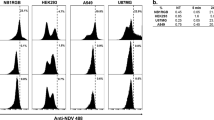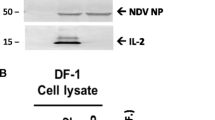Abstract
The destructive effect of Newcastle disease virus (NDV) strains on Burkitt lymphoma Daudi cells was investigated. Interaction of an active and UV-inactivated mesogenic strain (Roakin), as well as an active attenuated lentogenic strain (B1), grown in the allantoic sac of embryonated eggs, at high multiplicity, caused inhibition in cellular DNA synthesis and arrest in cell multiplication, eventually killing of the cells. The lentogenic strain cultivated in chicken fibroblasts exhibited only a moderate activity. The mechanism of the cytolytic effect is presumably linked to the increase in cell membrane permeability indicated by the elevation in51Cr release. Thus it appears that the massive adsorption and/or penetration of viral particles, active or UV-inactivated (or possibly a toxic component that resides in the virion), damages the plasma membrane and may be responsible for the killing of the cells.
Similar content being viewed by others
Abbreviations
- CEF :
-
chicken embryo fibroblasts
- NDV :
-
Newcastle disease virus
- B1 :
-
attenuated lentogenic NDV strain B1 V-188
- RO :
-
mesogenic (medium virulent) NDV strain Roakin/46 V-109 NJ
- CEF-B1 :
-
B1 cultivated in CEF
- RO-IRR :
-
UV-irradiated RO
- m.o.i. :
-
multiplicity of infection
- EID 50 :
-
median egg-infective dose
- PBS :
-
phosphate-buffered saline
References
Carrasco L (1979) Selective inhibition of protein synthesis in virus infected mammalian cells. J Virol 29:114–122
Carrasco L (1981) Modification of membrane permeability induced early in the infection by animal viruses. Virology 133:623–629
Carrasco L, Smith AL (1977) The inhibition of cell function after viral infection. FEBS Lett 76:11–15
Csatary LK, Eckhardt S, Bukosza I, Czegledi F, Fenyvesl C, Gergely P, Bodey B, Csatary CM (1993) Attenuated veterinary virus for the treatment of cancer. Cancer detection and prevention 17:619–627
Forda SR, Gillies G, Kelley JS, Micklem KJ, Pasternak CA (1982) Acute action of Sendai virus excitable on cells. Neurosci Lett 7 [Suppl 5]:71–72
Foster KA, Gill K, Micklem KJ, Pasternak CA (1980) Survey of virally mediated permeability changes. Biochem J 190:639–646
Fuchs P, Giberman E (1973) Enhancement of potassium influx in baby hamster kidney cells and chicken erythrocytes during adsorption of parainfluenza 1 (Sendai) virus. FEBS Lett 31:127–130
Garry RF, Bishop JM, Parker S, Westbrook K, Lewis G, Waite MRF (1979) Na+ and K+ concentrations and the regulation of protein synthesis in Sindbis virus infected chick cells. Virology 96:108–120
Grunwald-Beard L, Gamleil H, Parag G, Zakay-Rones Z (1991) Burkitt lymphoma Daudi cell killing by ultraviolet-inactivated vaccinia virus. J Cancer Res Clin Oncol 117:561–567
Hanks JH, Wallace J (1958) Determination of cell viability. Proc Exp Biol Med 98:188–190
Impraim CC, Foster KA, Micklem JK, Pasternak CA (1980) Nature of virally mediated changes in membrane permeability to small molecules. Biochem J 186:847–860
Klein E, Klein G, Nadkarni JS, Wigzell H, Clifford P (1968) Surface IGM-Kappa specificity on Burkitt lymphoma cell in vivo and derived cultures lines. Cancer Res 28:1300–1310
Ledbetter MLS, Libin M (1977) Control of protein synthesis in human fibroblasts by intracellular potassium. Exp Cell Res 105:223–236
Lorence RM, Rood PA, Kelley KW (1988) Newcastle disease virus as an antineoplastic agent: induction of tumor neurosis factor and augmentation of its cytotoxicity. J Natl Cancer Inst 80:1305–1312
Maeda T, Kawasaki K, Ohnishi S (1981) Interaction of influenza virus hemagglutinin with target membrane lipids is a key step in virus induced hemolysis and fusion at pH 5.2. Proc Natl Acad Sci USA 78:4133–4137
Munoz A, Castrillo JL, Carrasco L (1985) Modification of membrane permeability during Semliky Forest virus infection. Virology 146:203–212
Pasternak CA (1987) Viruses as toxins. Arch Virol 93:169–184
Pasternak CA, Alder GM, Bashford CL, Buckley CD, Micklem KJ, Patal K (1985) Cell damage by viruses, toxins and complement: common features of pore-formation and its inhibition by Ca++. Biochem Soc Symp 50:247–264
Reed LJ, Muench HA (1938) A simple method of estimating fifty percent endpoints. Am J Hyg 27:493–497
Rott R (1979) Molecular basis of infectivity and pathogenicity of myxovirus. Arch Virol 59:285–298
Schied A, Choppin PW (1974) Identification of biological activities of paramyxovirus glycoproteins: activation of fusion, hemolysis and infectivity by proteolytic cleavage of an inactive precursor protein of Sendai virus. Virology 57:475–490
Schirrmacher V, Ahlert T, Heicappell R, Appelhans B, Von Hoegen P (1986) Successful application of nononcogenic viruses for antimetastatic cancer immunotherapy. Cancer Rev 5:1–31
Scholtissek C (1986) Influenza A Viruses with noncleaved hemaglutinin are not internalized after adsorption. Arch Virol 90:159–163
Sever JL (1962) Application of a microtechnique to viral serological investigation. J Immunol 80:320–329
Shlomi Y, Zakay-Rones Z (1989) Sensitivity of Burkitt lymphoma Daudi cells to inactive influenza virus. J Cancer Res Clin Oncol 115:61–66
Shoham J, Hirsch R, Zakay-Rones Z, Osband ME, Bremert HJ (1990) Augmentation of tumor cell immunogencity by viruses —an approach to specific immunotherapy of cancer. Nat Immun Cell Growth Regul 9:165–172
Slosaris M, Levy B, Katz E, Levy R, Zakay-Rones Z (1989) Elevated virulence of Newcastle disease virus strains following serial passages in kidney cells in vitro. Avian Dis 33:248–253
Snir I (1988) Msc thesis
Spira G, Silvian I, Zakay-Rones Z (1977) Iodination of Newcastle disease virus envelope proteins with lacto-peroxidase. Isr J Med Sci 13:76–19
Weil-Hillman G, Zakay-Rones Z (1985) Arrest of Daudi cell growth by inactive influenza virus in vitro. Scanning Electron Microsc 4:1679–1686
Weil-Hillman G, Zakay-Rones Z (1987) Inhibition of Daudi tumor formation by inactive influenza virus in a nude mice model. Cancer J 1:208–213
Weil-Hillman G, Gamliel H, Friedman A, Zakay-Rones Z (1985) Visualization of the fate of inactive infulenza virus in Daudi cells in EM. Scanning Electron Microsc 4:1687–1693
Author information
Authors and Affiliations
Rights and permissions
About this article
Cite this article
Tzadok-David, Y., Metzkin-Eizenberg, M. & Zakay-Rones, Z. The effect of a mesogenic and a lentogenic Newcastle disease virus strain on Burkitt lymphoma Daudi cells. J Cancer Res Clin Oncol 121, 169–174 (1995). https://doi.org/10.1007/BF01198099
Received:
Accepted:
Issue Date:
DOI: https://doi.org/10.1007/BF01198099




